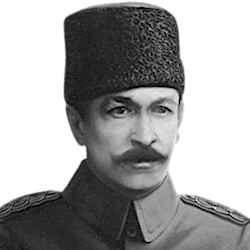
Selahattin Adil, born on 19 January 1882 in Istanbul, completed his education at the War Academy in 1902, followed by the Army Staff School in 1905. Initiating his military service, he undertook the role of an engineering officer in the construction of the Hejaz Railway on the Arabian Peninsula. In 1908, Selahattin Adil ascended to the rank of Major, subsequently assuming command of the 2nd Infantry Regiment two years later. The year 1911 saw him appointed as the Turkish military attaché in Bucharest. However, with the outbreak of war in Libya, Selahattin Adil redirected his efforts, becoming a pivotal figure among Turkish officers in organizing and leading local resistance against the Italians.
Post the Balkan Wars, Selahattin Adil Bey assumed the position of Chief of Staff of the Çanakkale Fortified Zone. Notably, he played a crucial role in orchestrating the defense of the Dardanelles, a feat that rendered the Allied fleet impassable on 18 March 1915. Rising to the rank of Colonel during the land battles, he continued to be a prominent Turkish figure throughout the First World War, commanding the 12th and 13th Divisions. Following the armistice, Selahattin Adil joined Mustafa Kemal's national movement, leading resistance against the French invasion forces in southern Anatolia. Upon the liberation of these regions, he commanded the Second Army in significant battles against the Greek forces, attaining the rank of General.
Amidst the Allied occupation of Istanbul, on 23 November 1922, the Ankara government appointed Selahattin Adil as the Commander of Istanbul. In October 1923, with the liberation of Istanbul, he assumed control from the Allied forces. After the establishment of the Turkish Republic, Selahattin Adil served in various government capacities. Between 1950 and 1954, he represented Ankara as a deputy in the parliament. His life journey concluded on 27 February 1961. The London Times marked his passing with the headline, "A Hero Died."
![]()





